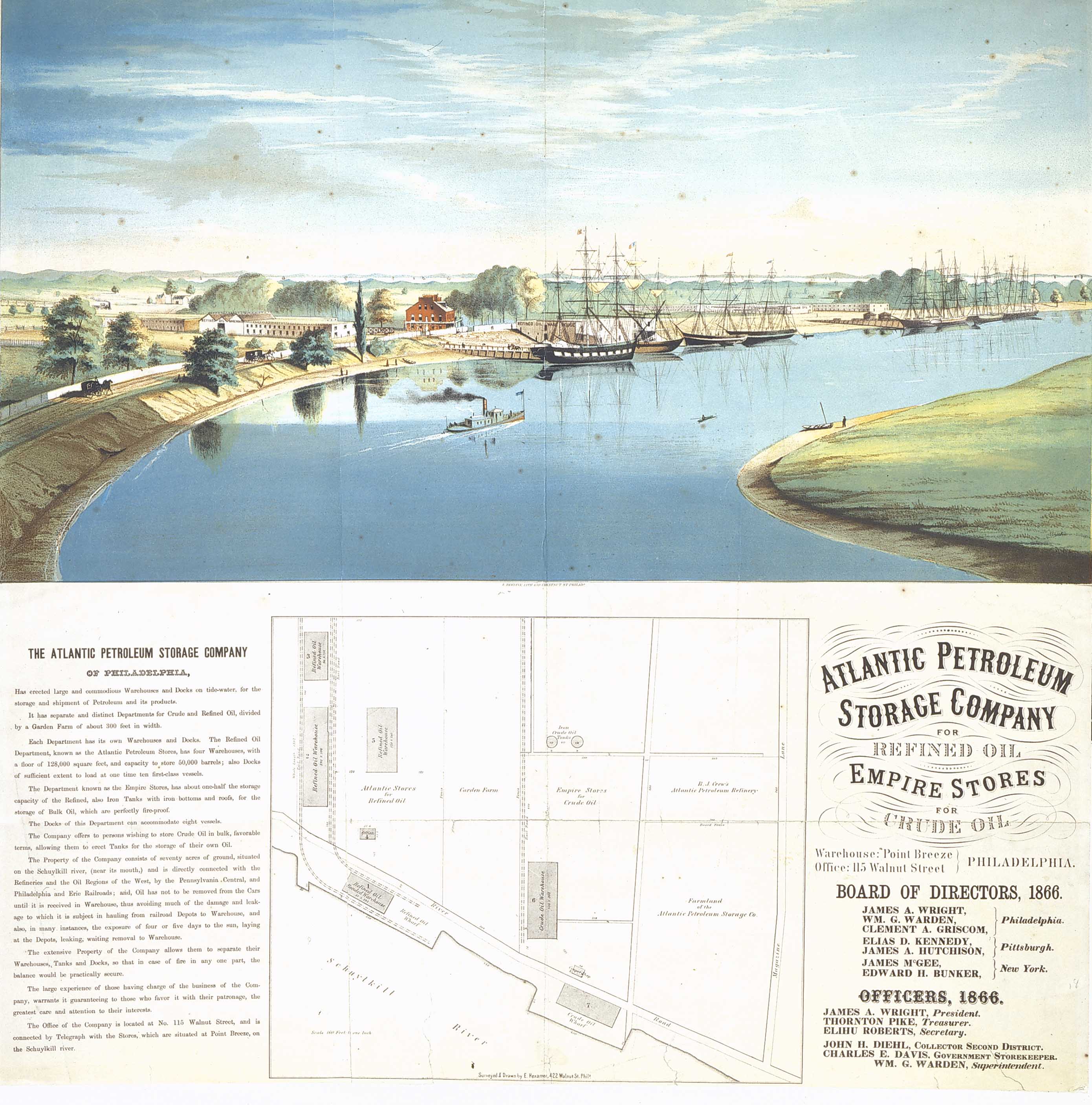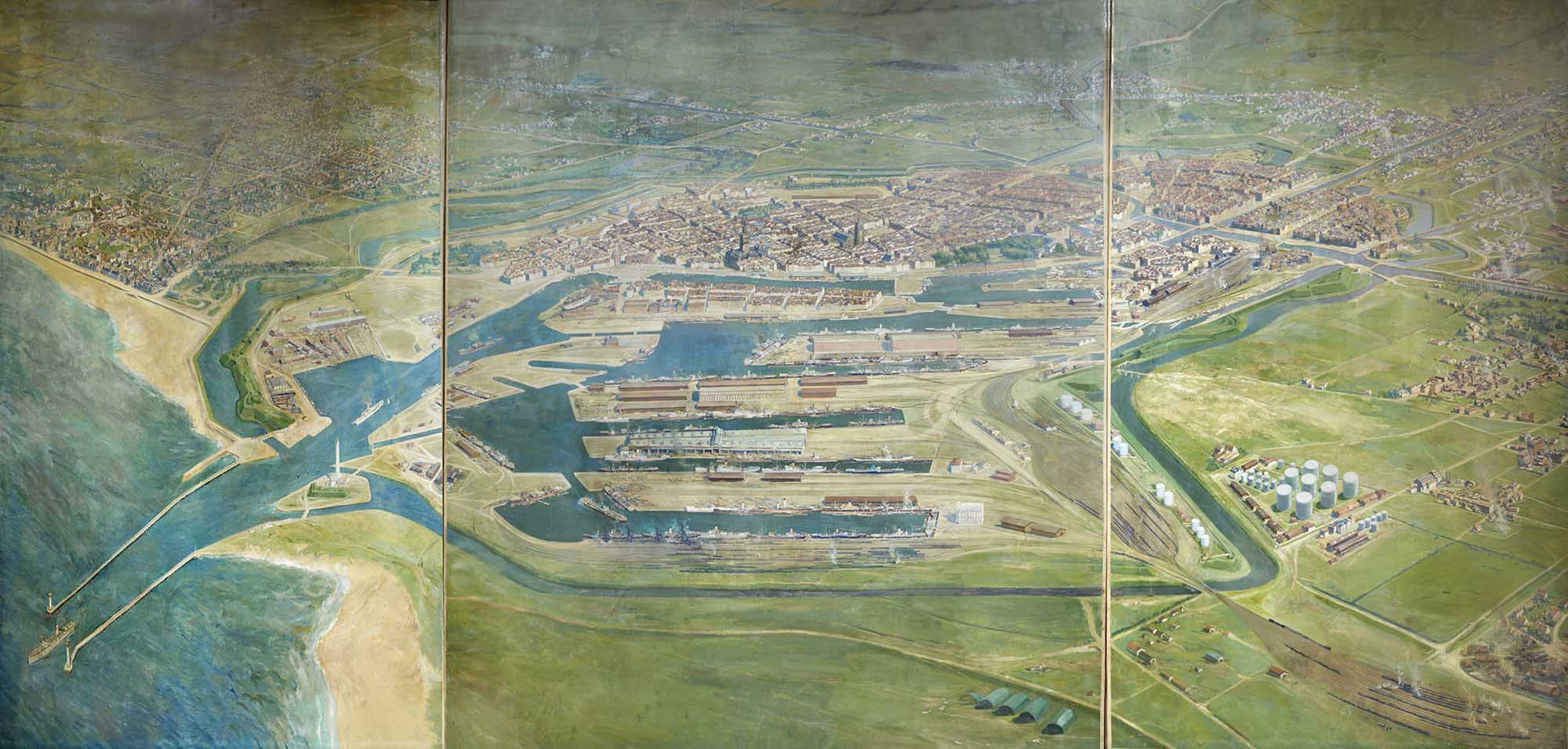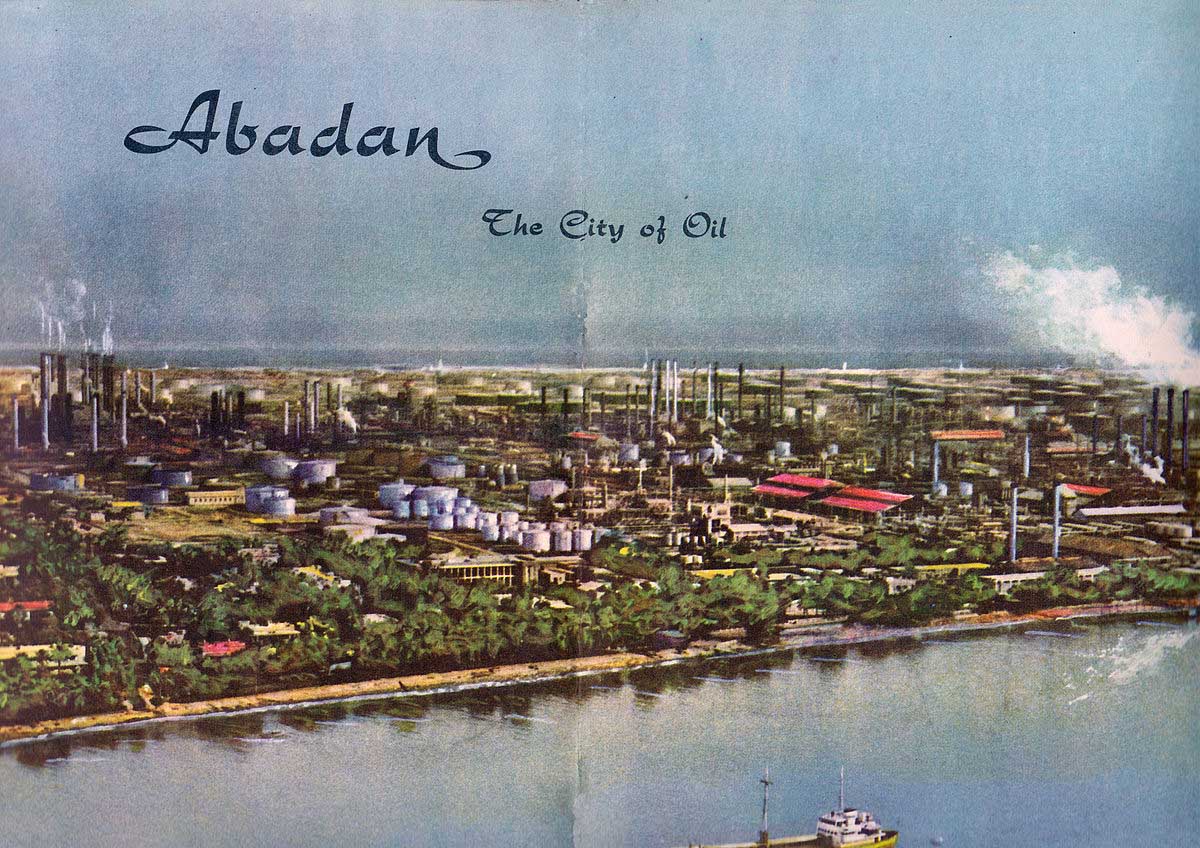The oil industry depends on water both for the refining process and for transportation, so many early oil companies sited petroleum storage and refineries near rivers and in port cities. Following industrial drilling in Canada and North America in 1858 and 1859, petroleum took the world by storm; in the early decades, it was particularly popular as lighting oil. Old and new ports – Philadelphia, Rotterdam, Dunkirk, Abadan – offered ideal conditions for storage and refining, and were well located to serve as hubs in the emerging global network of oil. Artists noticed the new structures, and their admiration and curiosity were visible in their artwork. Heads of corporations and public leaders used the depictions for promotion and perhaps decorated their offices with them.
The Atlantic Petroleum Storage Company on the Schuylkill River, Atlantic Petroleum Storage Company Advertisement, 1866. Library Company of Philadelphia.
One of the first refineries in the world, located on the Schuylkill River in Philadelphia, was originally built among apple yards [1]; it inspired an 1866 painting that the Atlantic Petroleum Storage Company for Refined Oil and the Empire Stores for Crude Oil both used for promotional purposes. Depicting the tranquil blue waters of the Schuylkill River and green pastures of farmland, the advertisement presented an image of a healthy landscape with proud sailing ships. The accompanying text highlighted the advantages of access to the oil-producing regions of Western Pennsylvania, setting the stage for extensive oil exports from Philadelphia to the world through the 19th century.
Painting of Pakhuismeesteren petroleum storage in Charlois, in the port of Rotterdam Willem van Dort in 1927 (The painting is in the possession of the Museum Rotterdam invnr. 83324, copyright unknown, https://museumrotterdam.nl/collectie/item/83324itemReturnStart=0&objectrow=0&itemReturnSearch=83324)
The new product also changed the ports where it arrived, inspiring artists to create new depictions. Petroleum came from the wells of Pennsylvania to Rotterdam as early as 1862. There it was originally stored by Pakhuismeesteren, a company that had roots in the Dutch East India Company and had traditionally dealt in tea and coffee. The owners, the de Monchy family, were one of the drivers of the Rotterdam port development and the expansion of the city [2]. The local painter Willem van Dort (1905 – 1996) captured Pakhuismeesteren’s role in the oil industry in a painting that shows the town of Robbenoordsehaven in Charlois in 1927 (before the move to Pernis in 1935). Two huge oil storage tanks stand in the center of the painting, one marked with the company name and the number 2. Meanwhile workers roll oil barrels in front of the harbor scenery, with mighty steam ships in the background. In the absence of more specific information on the painting, we can only imagine that the painting once occupied a special place in the offices of the company.
View of the City of Dunkirk around 1923. Collection of the Port Museum of Dunkirk.
Pride in oil storage and handling seems to have inspired the painting of the French city of Dunkirk too. Viewing the scene from the sea, this large anonymous painting from 1923 puts the port activity at center stage. Former fortifications have been made into large green zones separating the old city from its rural surroundings. This green belt appears ready to be populated with (industrial) activities: multiple oil storage tanks visible on both sides of the river give a first idea of development, a new industrial future after World War I. The painter shows the tanks lit by the sun, and the new structures are gleaming white in the front right of the image. That future would come almost immediately to Dunkirk with the development of large refineries and storage sites.
View of Abadan refinery, 1960 (postcard https://upload.wikimedia.org/wikipedia/commons/thumb/0/09/Abadan_the_city_of_Oil.jpg/1200px-Abadan_the_city_of_Oil.jpg)
Perhaps the most striking depiction of an oil port is on a postcard of the Persian oil port of Abadan from 1960. Bright white oil tanks and proud tall chimneys show the extent of oil production. Abadan, which calls itself “The City of Oil,” is one of several company towns in in a formerly largely unsettled area in the province of Khuzestan in southern Iran. There, the Anglo-Persian Petroleum company (later named Anglo-Iranian Petroleum Company, then British Petroleum, and now BP) built ports, refineries, and company towns in the early 20th century to produce, transfer, and refine oil. In the absence of existing cities, the company developed housing for expatriates and workers, and new urban amenities such as swimming pools, hospitals, and members’ clubs. Petroleum thus became the vehicle for the introduction of new lifestyles and built spaces.
Over the decades, artists have continued to depict oil in the fine arts, maintaining a fascination with oil storage, petroleum refining, and ports around the world (including Saja Hagens, whose work was recently featured in Portus) [3]. Meanwhile the context of oil has changed. Today, industrial oil facilities in ports are a huge business with specific functional requirements, and ports continue to promote themselves. For example, the Port of Rotterdam touts itself as the “Ideal oil port for the supply of crude oil for Europe” with a photo of oil storage tanks [4].
But oil ports no longer stand as a harbinger of a bright new future. News stories for the general public show oil facilities mostly in conjunction with stories about disasters and social conflict—recent safety concerns at the Philadelphia refinery, the dangers of oil transportation by rail from North Dakota to the over hundred-year old refineries on the Schuylkill River in Philadelphia, and clashes between police and protesters over pipelines routed across native land in the mid-western US [5]. The news also sometimes shows the changing industrial landscape, such as the partial closing of the Total refinery in Dunkirk, in the face of decreasing demand. As renewable energies gain more clients, as refineries start to close, and port functions change, we are in a new era of cleanup, redevelopment, and reimagination. Oil ports around the world need to explore new uses for these industrial sites, and artists may develop new ways to paint them.
Notes
[1] Carola Hein (2016) “Refineries (Oil)” The Encyclopedia of Greater Philadelphia, https://philadelphiaencyclopedia.org/archive/refineries-oil
[2] LOOHUIS, J. G. 1952. Rotterdam als Petroleumhaven in de Negentiende Eeuw, Rotterdam, AD. Donker Uitgever. 71) LAAR, P. VAN DE 2000. Stad van formaat: Geschiedenis van Rotterdam in de negentiende en twintigste eeuw, Zwolle.; SCHOOR, A. VAN DER 2013. de Dorpen van Rotterdam: van Ontstaan tot Annexatie, Ad Donker Uitgeversmaatschappij bv.
[3] Moretti Marta, “I colorati paesaggi portuali di Saja Hagens” PORTUS: the online magazine of RETE, n.32, December 2016, Year XVI, Venice, RETE Publisher, ISSN 2282-5789, URL: https://portusonline.org/en/the-colorful-harbourscapes-of-sasja-hagens/
[4] https://www.portofrotterdam.com/en/cargo-industry/liquid-bulk/crude-oil-storage-and-throughput
[5] David Cheng, “Crews battled a fire at the Philadelphia Energy Solutions refinery.” NBC10, 10.12.2016; “PES Philadelphia refinery fire extinguished, no injuries,” Reuters 11.12.2016, https://www.reuters.com/article/us-refinery-fire-pes-philadelphia-idUSKBN140049; Susan Phillips 20.2.2015, “Heavy flaring at Philadelphia refinery sends black smoke into the air” https://stateimpact.npr.org/pennsylvania/2015/02/20/heavy-flaring-at-philadelphia-refinery-sends-black-smoke-into-the-air/; MAYKUTH, ANDREW. 2015c. Oil-train accidents raise concern in Phila. Philadelphia Inquirer, February 23, MAYKUTH, ANDREW 2015a. City Council wants tighter oil train rules. Philadelphia Inquirer.; WOLK, CORYN S. 2014. A Near Miss from Disaster: Oil Train Derails in Philadelphia. Protecting Our Waters [Online]. Available: https://protectingourwaters.wordpress.com/2014/01/20/a-near-miss-from-disaster-oil-train-derails-in-philadelphia/ [Accessed January 20]. 2014. Train Carrying Crude Oil Derails in Pennsylvania. New York Times.
Head Image: The Belmont Petroleum Refinery stood on the Schuylkill River in 1866; it was later dismantled because of its location upstream from the city’s water supply. Library Company of Philadelphia.



